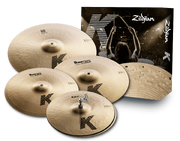
A pack of Zildjian's K Cymbals. Included are 14" hi-hats, a 16" crash, an 18" crash, and a 20" ride. It is listed for around $1,210.
A cymbal is a musical instrument that is a round plate with an elevated bell in the middle. They are found everywhere from the finger cymbals of belly-dancers to the suspended cymbal found in bands and orchestras, Cymbals are one of two main instruments commonly used on a drum kit, along with the drums itself. They are also a staple in orchestral works, highlighting loud and important moments in a piece. They have been made and used for thousands of years.
Typical Making of a Cymbal[]
A cymbal is made in two ways; either by sheet metal or with castings. Low-end cymbals tend to be made of sheet metal, like Zildjian's I Series Cymbals. Higher-end cymbal are made usually out of castings, like Sabian's AAX Series Cymbals.
There are two main elements from the periodic table used in cymbal making, them being Copper () and Tin (). These elements are used in alloys, or a mix of at least one metallic element with another element. The highest quality of these alloys is B20 Bronze (), made from 80% Copper and 20% Tin. Manufacturers like Zildjian or Sabian have sold hundreds of millions of these B20 cymbals to percussionists all around the world.
Another alloy used in cymbal making is B8 Bronze (). It consists of about 92% Copper and 8% Tin. B8 bronze cymbals are made from sheet metal rather than castings due to the fact that getting sheets of B8 bronze are cheaper and less time-consuming. Often, punk bands use B8 bronze cymbals to cut through the sound of electric guitars. Paiste, a Swiss cymbal manufacturer, is well-known for their high quality B8 cymbals.
One more alloy used, and the lowest quality, is Brass (). Brass cymbals are often beginner cymbals and don't sound as nice as B8 bronze cymbals. Like B8 bronze, brass cymbals are made from sheet metal. Meinl, a German manufacturer, has many brass cymbals, notably in their HCS Series of cymbals. Since the material is cheap, these cymbals are sold cheaply.
Cast cymbals are heated up in an oven and then pressed to have a bell in it. After that, they are cut down to the shape of a cymbal. A tool known as a lathe polished the cymbal and gives it the iconic golden look known today.
Cymbals in Ensembles[]
Concert Band and Orchestra[]
There are two main types of cymbals used in concert bands and orchestras; the suspended cymbal and clash cymbals, or piatti. They often come in during loud and powerful sections of a piece.

A gooseneck stand with a cymbal cradle and cymbals.
Clash Cymbals, or Piatti, are a pair of cymbals clashed against each other. Variations of piatti go back thousands of years to many different locations, like China or Turkey. In order to actually hold the cymbals, leather straps are used. The straps are tied to the cymbal and the knot is secured by the bell. It is important to make sure the straps are tied on tightly, or they might break and cause a disturbance to a performance. This viral video is a perfect example on why cymbal straps need to be tied properly and tightly (around the 1:06 mark). The straps are held like a drum stick; the index, middle, ring, and pinky fingers wrap around the strap with the thumb on top. For when clash cymbals are not used, they are put inside a cymbal cradle, or a piece of hardware with four slots to accommodate clash cymbals.
Suspended Cymbals are cymbals that are suspended on a stand. The stand in question comes in two forms; a regular stand like on a drum kit, or a gooseneck stand, where a strap is tied on a cymbal like piatti but the strap is then attached to a hook. Gooseneck stands often have a wide arm in order to let a cymbal move. Suspended cymbals often use soft yarn mallets like a Marimba. Drumsticks are also used.
Marching Band, Drum Corps, and Indoor Percussion Ensembles[]
In a marching setting, piatti and suspended cymbals are also used. However, marching cymbals often incorporate visuals, or movements to enhance the performance of a piece. There are even more techniques used for marching cymbals than orchestral cymbals. Straps for marching cymbals are held a little differently. To perform visuals and even cymbal tricks, players slide their hand inside the loop of the strap. The strap is usually a little bigger than the hand itself, allowing for movement.
Suspended cymbals are also used in a marching band, but are seen in the front ensemble, or pit. They are often angled to allow for easier playing. A typical marimba and vibraphone will have a long metal bar on the frame to attach cymbals and other accessories to. For auxiliary percussion, there are loads of cymbals that are used. Additionally, cymbals may be mounted on a bass drum and are hit with either a thin stick or another cymbal.
Common Types of Cymbals[]
Listed below is a chart containing common cymbal types, a description of them, and the sizes they come in,
| Type of Cymbal | Description | Sizes |
|---|---|---|
| Crash Cymbal | a cymbal designed to make an explosive "crash sound", used heavily in all genres | 13"-24" |
| Ride Cymbal | a cymbal used in jazz, rock, and other genres to lay steady beats; often the bell is hit to make a different sound | 20"-24", some even up to 30" |
| Crash-Ride | a cymbal that combines the explosiveness of a crash with the capability of a ride | 16'-24' |
| Splash Cymbal | a small cymbal that is used to add accents while playing | 6"-12" |
| Stack Cymbal | two or more cymbals (often splash cymbals) stacked on top of each other | 6"-14" |
| China Cymbal | a cymbal with a unique shape and trashy sound, often seen in metal bands | 8"-24", some even up to 27" |
| Bell Cymbal | a small and thick cymbal that has a long sustain, often put on top of crash cymbals | 6"-10", some up to 13" |
| Hi-hat | a pair of two cymbals on a stand controlled by a pedal; the top cymbal is the one that moves | 13"-16" |
| Finger Cymbals (Zills) | a pair of small cymbals held by small straps, usually played by belly dancers in Arabic countries | 2"-3" |
All measured units are in Inches (x").





